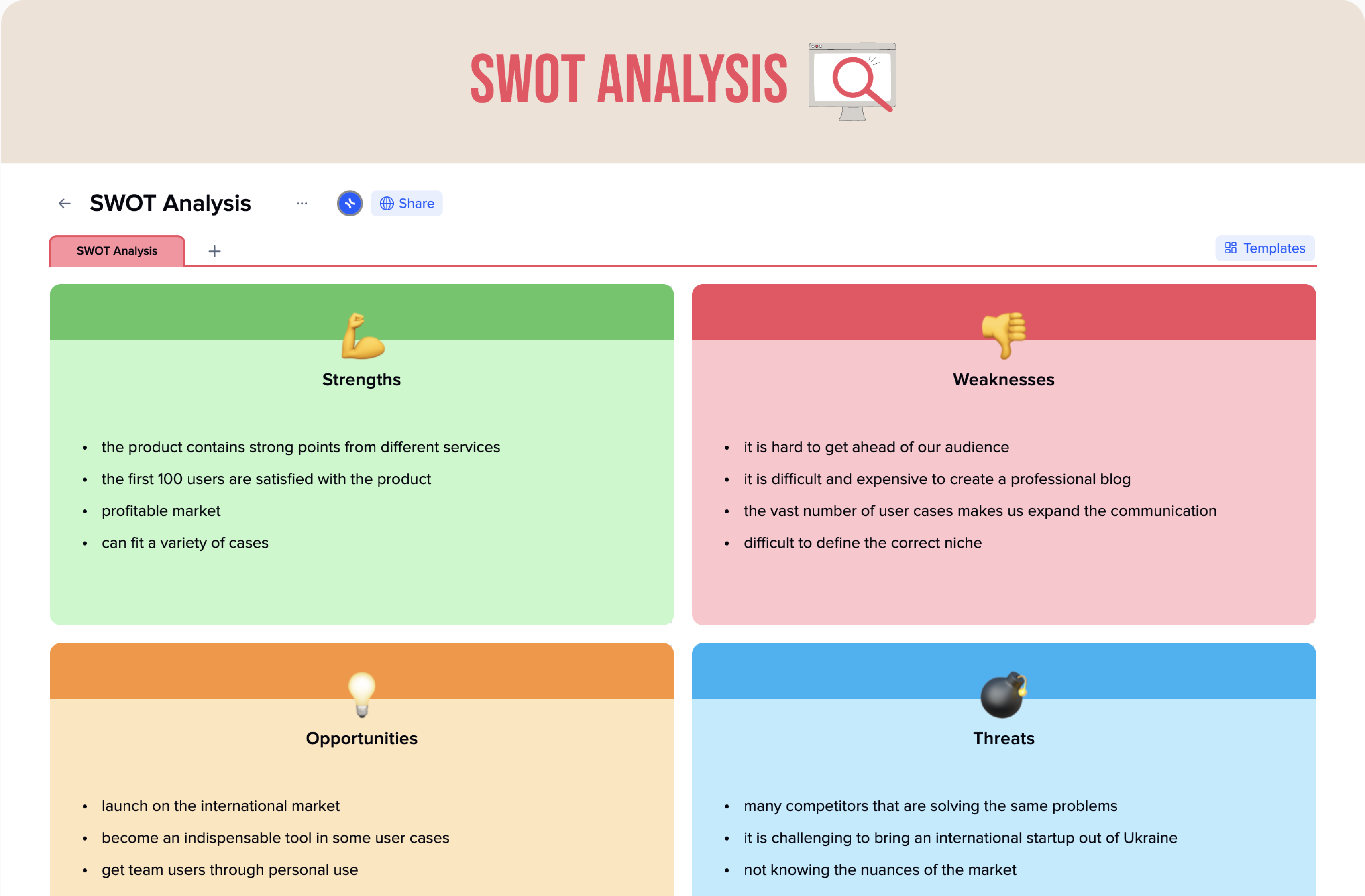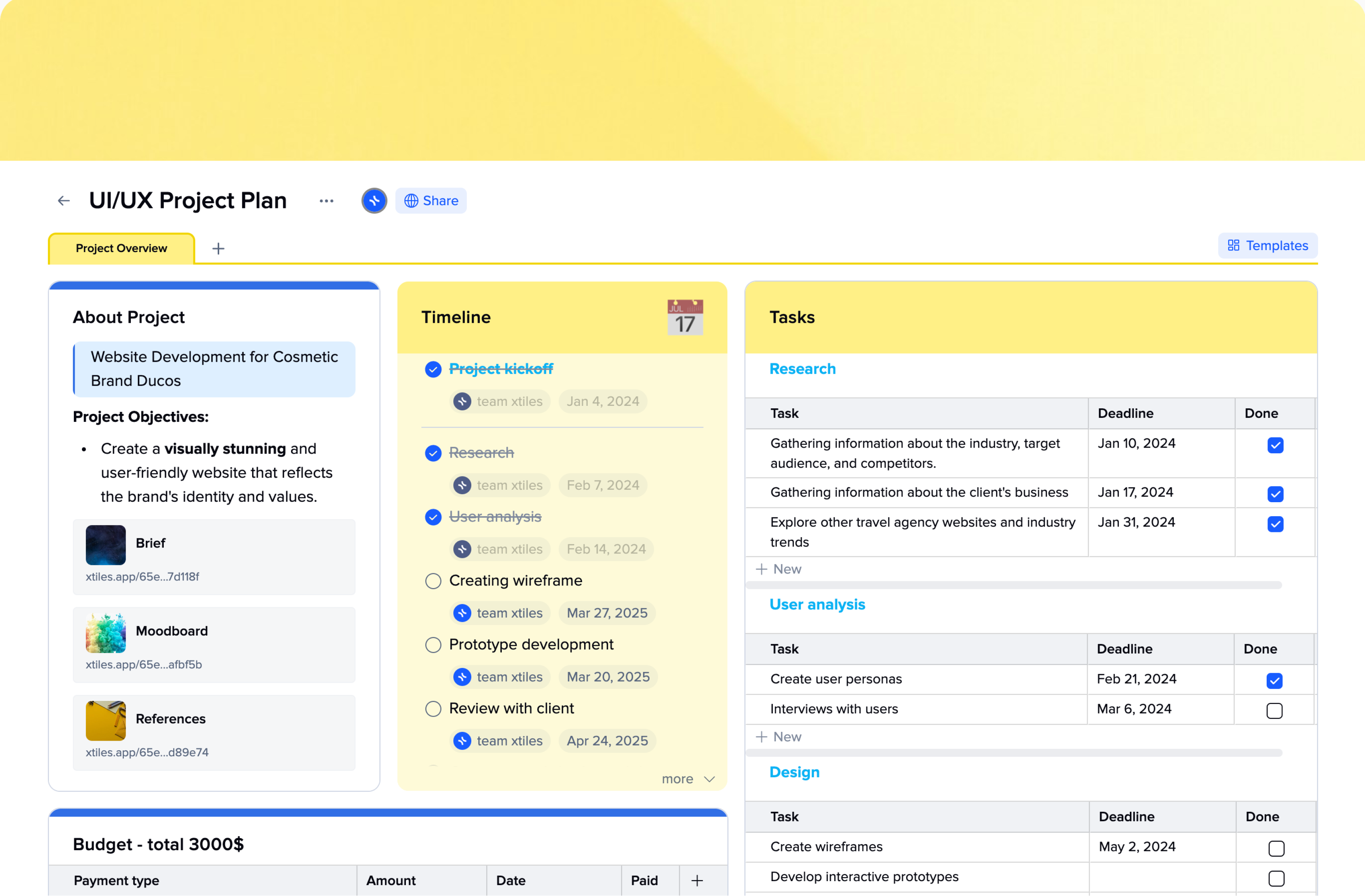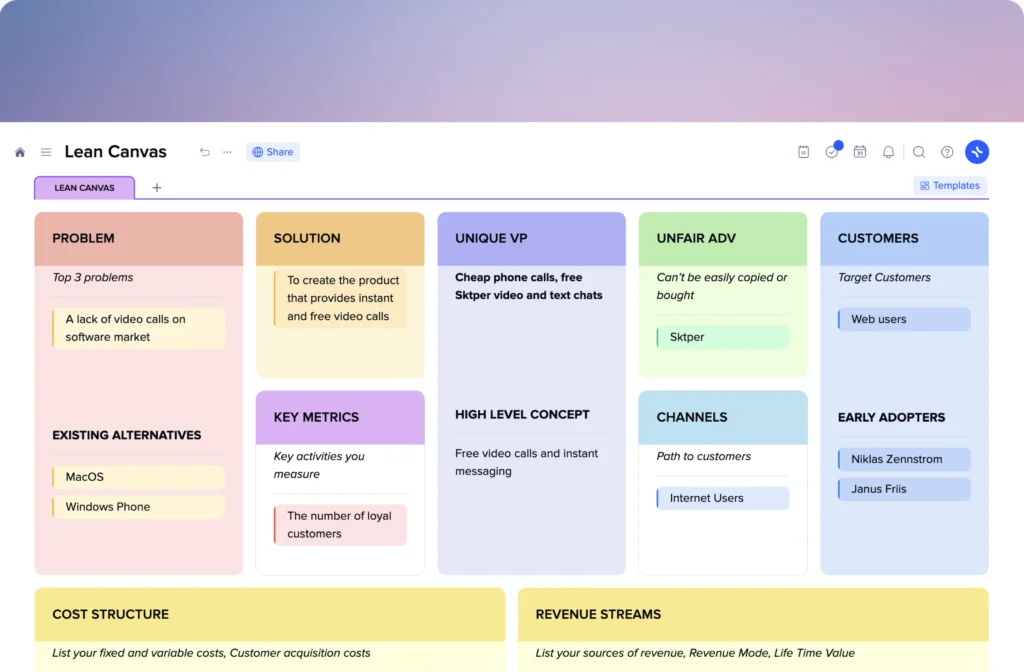How to Do a Detailed Analysis with the xTiles SWOT Analysis Template?
The xTiles SWOT Analysis Template is a simple one-page document with four dedicated sections for strengths, weaknesses, opportunities, and threats. However, you’re free to add more pages (simply press the “+” button near the existing tab) if you need a space for thinking and brainstorming. Also, in the end, when everything is identified, you can start setting tasks based on your SWOT analysis directly from the template, turning it into a project plan for further actions.
Every point in your SWOT Analyses in xTiles can be much more than a line of text. You can expand it to a note and get more space to note down details or explanations. Also, some factors in your SWOT Analysis can be expanded to a separate page or even a full-scale sub-project where you can work on resolving it.
Now, let’s check in detail every element of this simple yet polished diagram and add your own SWOT Analysis using the template, so in the end, you will have a fully representative picture of your, employee’s, or company’s strengths and weaknesses identified.
Strength
That would be the part where you mention your strong points. What do you do particularly well? What are you proud of? What do others keep praising you for?
However, if you analyze your project/product/company and not your personal features, you need to put the project at the center of your questions. What advantages can your project offer to others? Why will it be useful for others? What will they find great about it?
For many, the part where you have to speak about your advantages and why you or your idea is fantastic is the hardest. In a world full of anxiety and low self-esteem, it’s super easy to fill the part of the diagram devoted to Weakness rather than come up with a few comprehensive advantages to convince yourself, your stakeholders, or your college professor that your internal strengths are something worth not only mentioning but being used in future planning.
We kindly ask you to give yourself some time while gathering the data for this part of your SWOT analysis. You may go and ask others’ opinions to get a better understanding of what you’re about to do. Sometimes, their judgments might be negative and better suitable for the next section. However, they may be what you yourself couldn’t see.
If you analyze your company or product, you can gather a meeting to go over your company’s strengths, and internal processes that distinguish you to discover opportunities that were hidden. Also, when working on this part, keep in mind what is your main point — increase brand recognition, increase financial resources, boost business performance, forecast market trends, etc.
Weakness
Now, you need to identify what needs improvement. These factors aren’t threats yet, but without you doing something/changing something, they might become dangerous. Sometimes, weaknesses can come from the inside, too. Looking only outside to find external factors preventing your project from succeeding might lead to overlooking internal factors that might have the same effect. An effective SWOT Analysis template allows you to focus on both, external and internal weaknesses.
Think about what is the hardest for you to achieve. Think of obstacles that prevented you from the desired outcome. Sometimes new and raw ideas seem perfect, with no hardships at all. If this is your case, give yourself some extra time for consideration.
You may check your strong points from the previous part and try to find their opposites. Still nothing? Well, maybe, indeed, you have come up with something magnificent that doesn’t have weaknesses. However, you may ask for other opinions once more. Other people are quick to come up with sour judgments, but that’s what we need (if they were fair) to move to the next part.
You can share your SWOT Analysis draft with your teammates to ensure everything is correct. They can add their comments and reactions to provide valuable insights and help you identify factors you overlooked.
Opportunities
It’s time to identify internal and external opportunities. That part is where you can grow and develop. What has been there for ages, but you haven’t paid enough attention to it? What things/actions you neglected for different reasons can benefit your company or project?
If your project only starts, that section will help you define where it may go. The longer your project exists, the harder it will be to find new opportunities. However, they may appear suddenly after some abrupt changes in society. For example, the CoronaVirus Pandemic significantly affected the world order we were used to, bringing many opportunities to many kinds of people and businesses.
Looking for new opportunities, you can check your competitors and what new they are trying to develop their projects. If your SWOT Analysis is dedicated to your personal development, you can check LinkedIn pages of people with the same position or position you would like to get someday.
Threats
That part will describe or at least count what you should be very well aware of to avoid losses. These obstacles may be only potential, which means they will not necessarily happen. However, preparing and discussing them now will take less of your resources than if you will need to resolve them on-site.
It is the last section, so sometimes people skip it because they are already tired or prefer not to think about a bad outcome. However, if you’re determined to get a clear and up-to-date SWOT matrix for your business or project, you must finish powerfully.
You may analyze external threats, like emerging competitors, new market trends, market volatility, etc., and internal threats, like your past business decisions, your business strategies, current technical expertise, etc., to identify risks.
Usually, others’ experience helps prevent similar difficulties or at least show what to be aware of. So, check your competitors or even companies from other industries that face the same issues.
Now, you need to summarize your SWOT analysis with a well-defined action plan. Creating a strategy to move on according to what you’ve just found out is the natural continuation of your analysis. Otherwise, all your efforts and time will be wasted.
After you finish the xTiles SWOT Analysis Template, you may go on with other templates for strategic planning and management to create a great strategy for your business’s success. Check our Template Gallery to find what you need to continue the process.
























